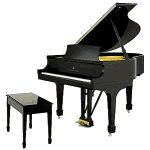

Choose the letter which begins musical term that you would like to learn about:
| A | B | C | D | E | F | G | H | I | J | K | L | M | N | O | P | Q | R | S | T | U | V | W | X | Y | Z |
PAbbreviation for piano, soft.
PacatoCalm, quiet.
Passing tonesUnaccented notes which move conjunctly between two chords to which they do not belong harmonically.
PausaA rest.
PensierosoContemplative, thoughtful.
Percussion familyInstruments made of sonorous material that produce sounds of definite or indefinite pitch when shaken or struck, including drums, rattles, bells, gongs, and xylophones.
PerfectA term used to label fourth, fifth, and octave intervals. It corresponds to the major, as given to seconds, thirds, sixths, and sevenths.
Perfect authentic cadenceA special cadence in which both the dominant (V) and tonic (I) chords have their root in the bass and the soprano ascends of descends stepwise to the root of the tonic.
Perfect cadenceThe chordal progression of dominant to tonic, in a major key V-I, in minor V-i.
Perfect intervalInterval of an octave, fifth, or fourth without alteration.
Perfect pitchThe ability to hear and identify a note without any other musical support.
Perfect plagal cadenceA plagal cadence in which the soprano note remains unchanged in the progression IV-I.
PesanteHeavy.
PetiteLittle.
Peu a peuLittle by little.
PhraseA relatively short portion of a melodic line which expresses a musical idea, comparable to a line or sentence in poetry.
Phrygian cadenceA harmonic close which originaled in the Phrygian mode as the final cadence. In modern usage, it is any transposition of the progression IV6 to V
PianissimoVery soft.
PianississimoVery, very soft; the softest common dynamic marking.
PianoSoft. Pianoforte.
Pianoforte"Soft-loud." A keyboard instrument, the full name for the piano, on which sound is produced by hammers striking strings when keys are pressed. It has 88 keys.
Picardy thirdThe term for the raising of the third, making a major triad, in the final chord of a composition which is in a minor key. The practice originated about 1500 and extended through the Baroque period.
PitchThe highness or lowness of a tone, as determined by the number of vibrations in the sound.
PiuMore. Used with other terms, e.g. piu mosso, more motion.
Pizzicato"Pinched." On string instruments, plucking the string.
Plagal cadenceSometimes called the "amen" cadence because it is often used at the end of hymns. The chordal progression of subdominant to tonic, in a major key IV-I, in minor iv-i.
PocoLittle. Used with other terms, e.g. poco accel., also, poco a poco, little by little.
Poco ced., CedereA little slower.
Poco piu mossoA little more motion.
PoiThen or afterwards, e.g. poi No. 3, then No. 3.
Postlude"Play after." The final piece in a multi-movement work. Organ piece played at the end of a church service.
Prelude"Play before." An introductory movement or piece.
PremiereFirst performance.
PrestissimoVery, very fast. The fastest tempo.
PrestoVery quick.
PrimoFirst.
PrincipalInstrumental section leader.
PrologueAn introductory piece that presents the background for an opera.
 |

|
| A | B | C | D | E | F | G | H | I | J | K | L | M | N | O | P | Q | R | S | T | U | V | W | X | Y | Z |
Belwin Pocket Dictionary of Music: Music Theory Dictionary
By Dr. William Lee
Students may purchase a copy for home use at cost
Many thanks to Dearest for everything!
is located
in Fairfax, Virginia
Over 30 Years
~~
Piano, Organ
Electric Keyboard
Accompanying
All rights reserved.
Site design and maintenance by
O'Connor O'Riginals Web Design